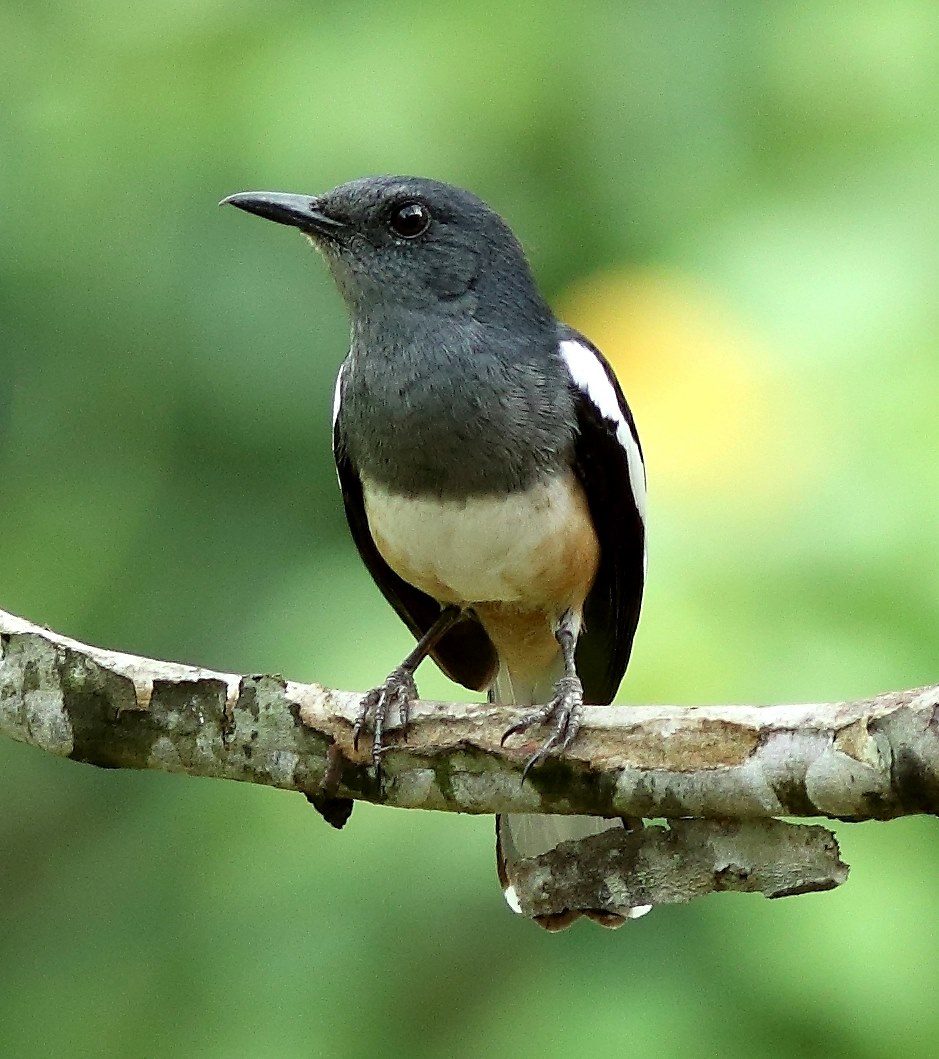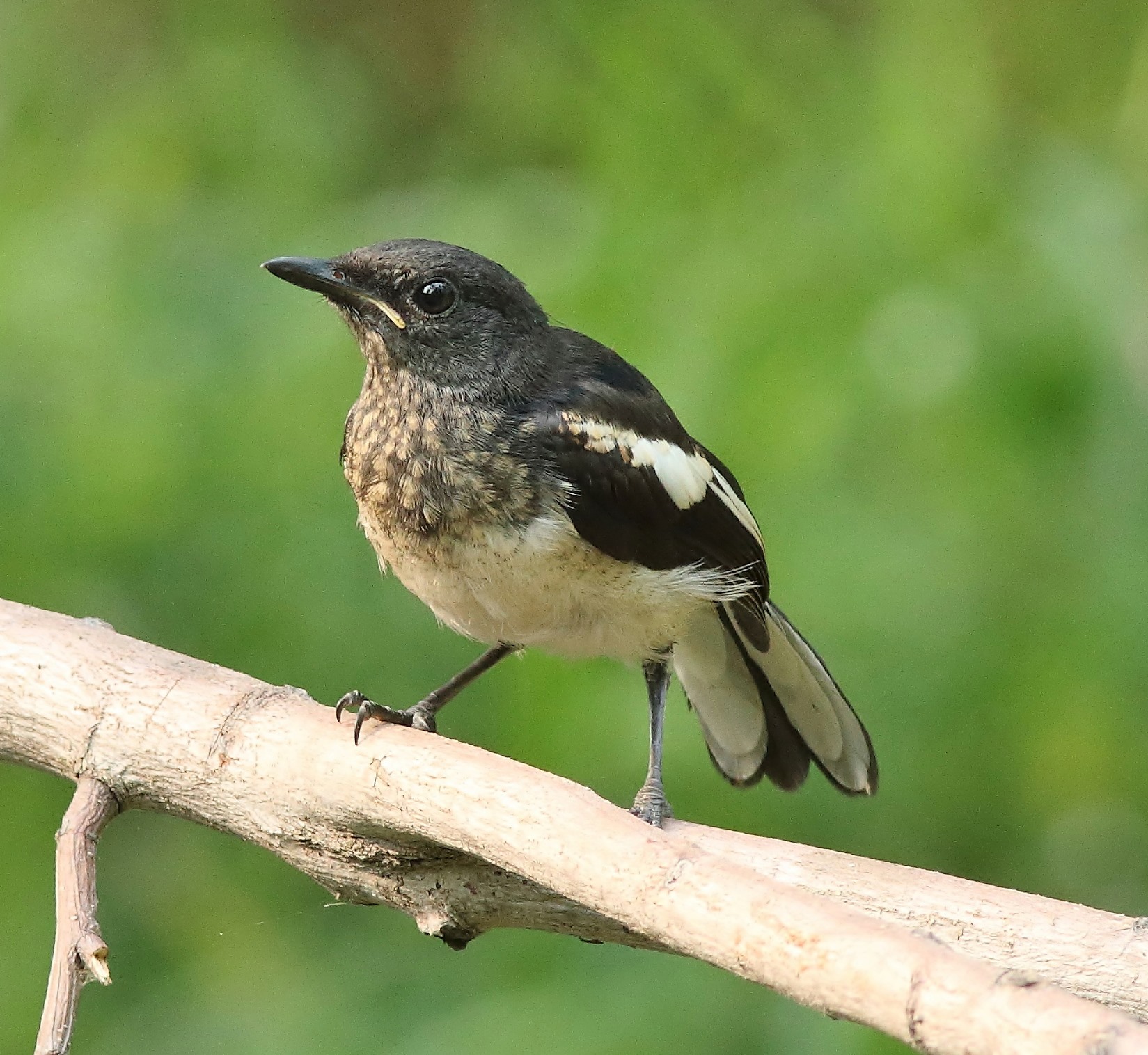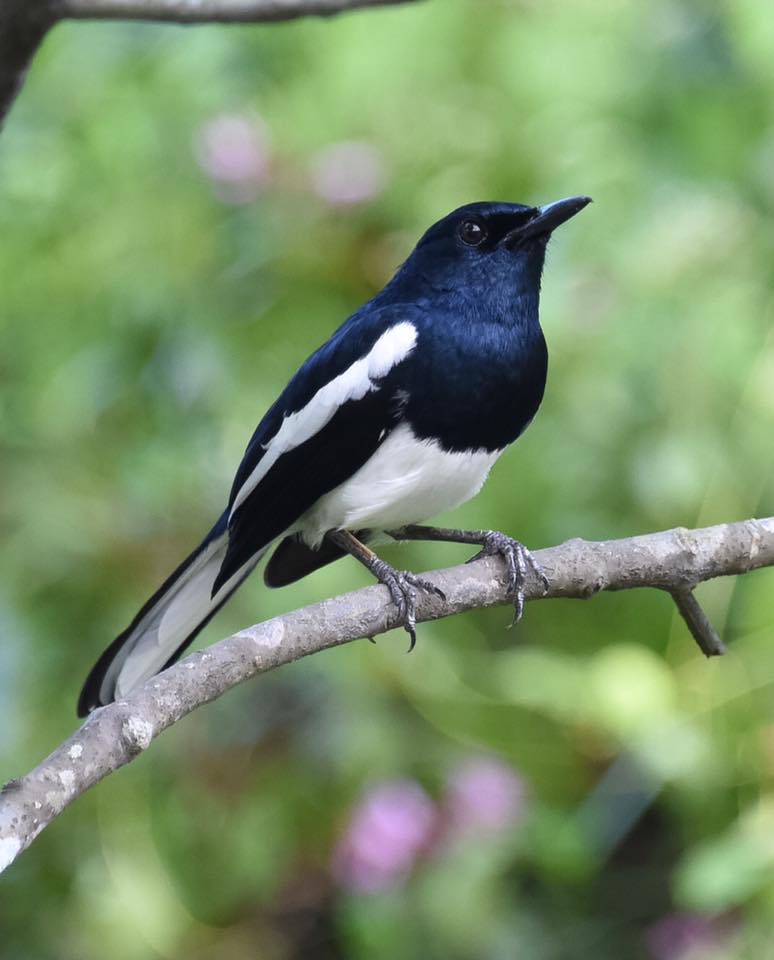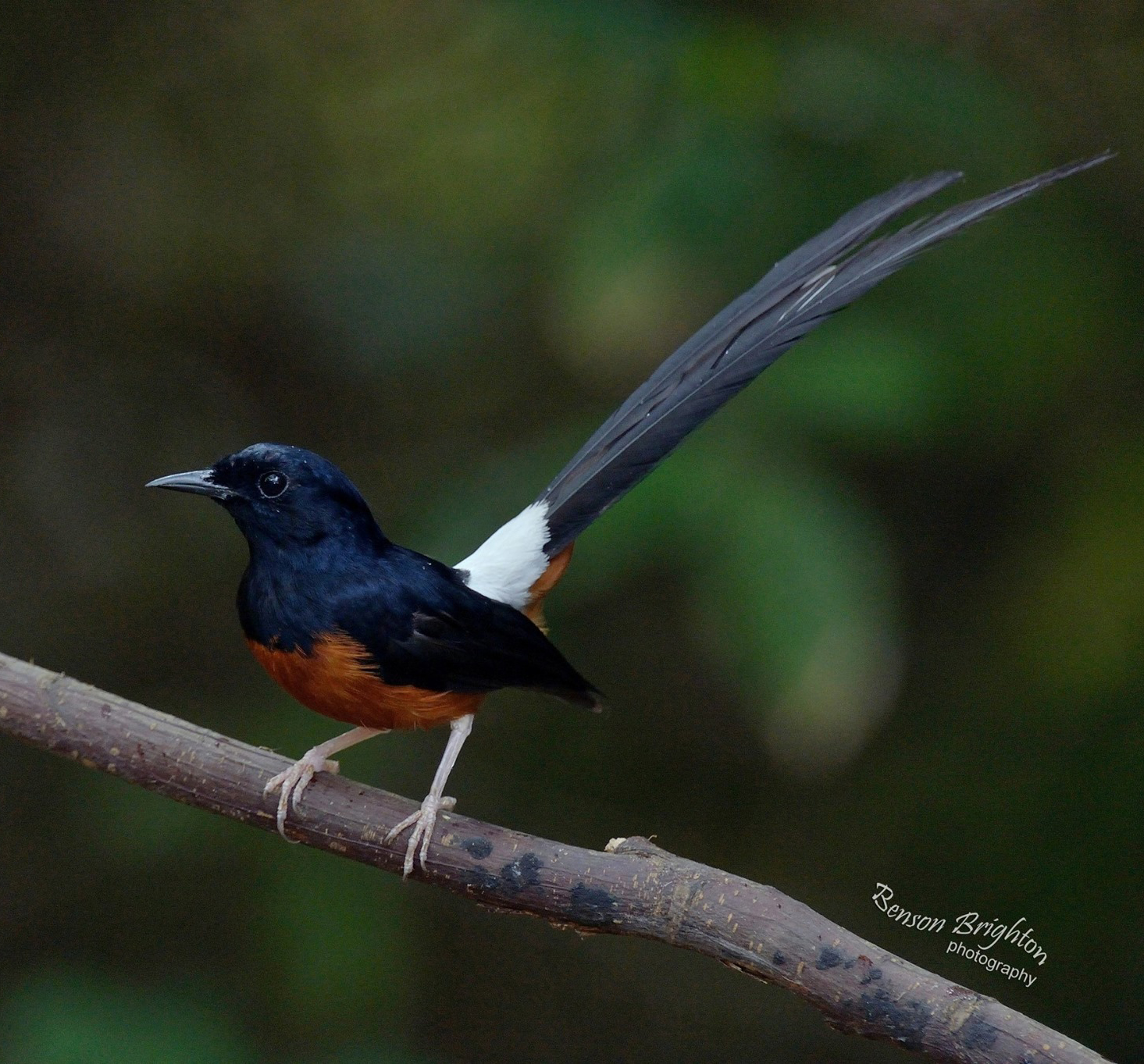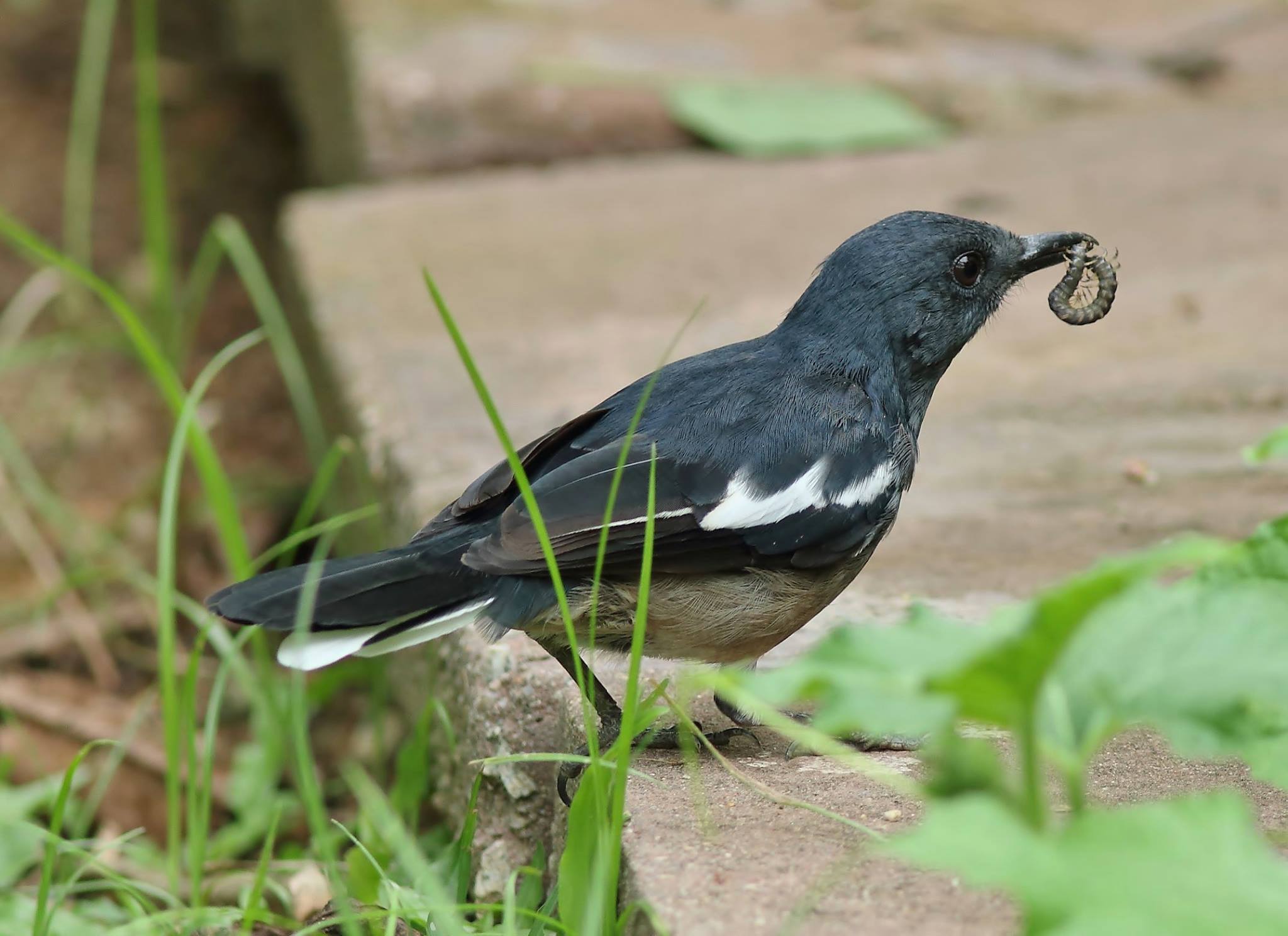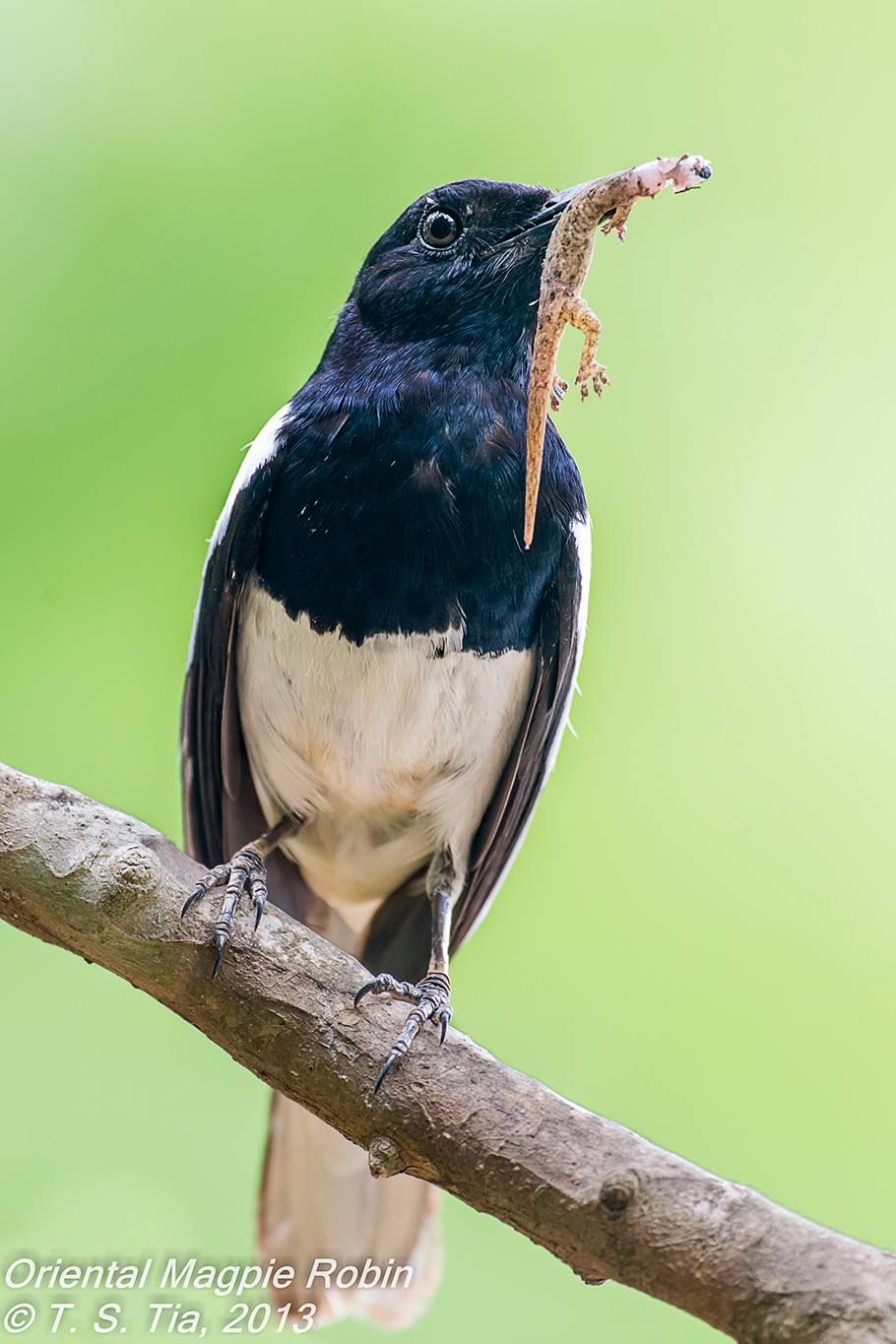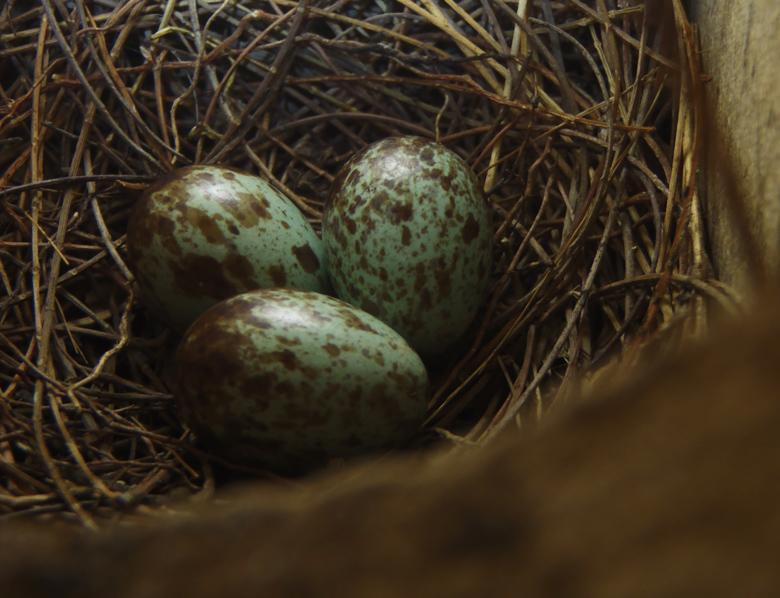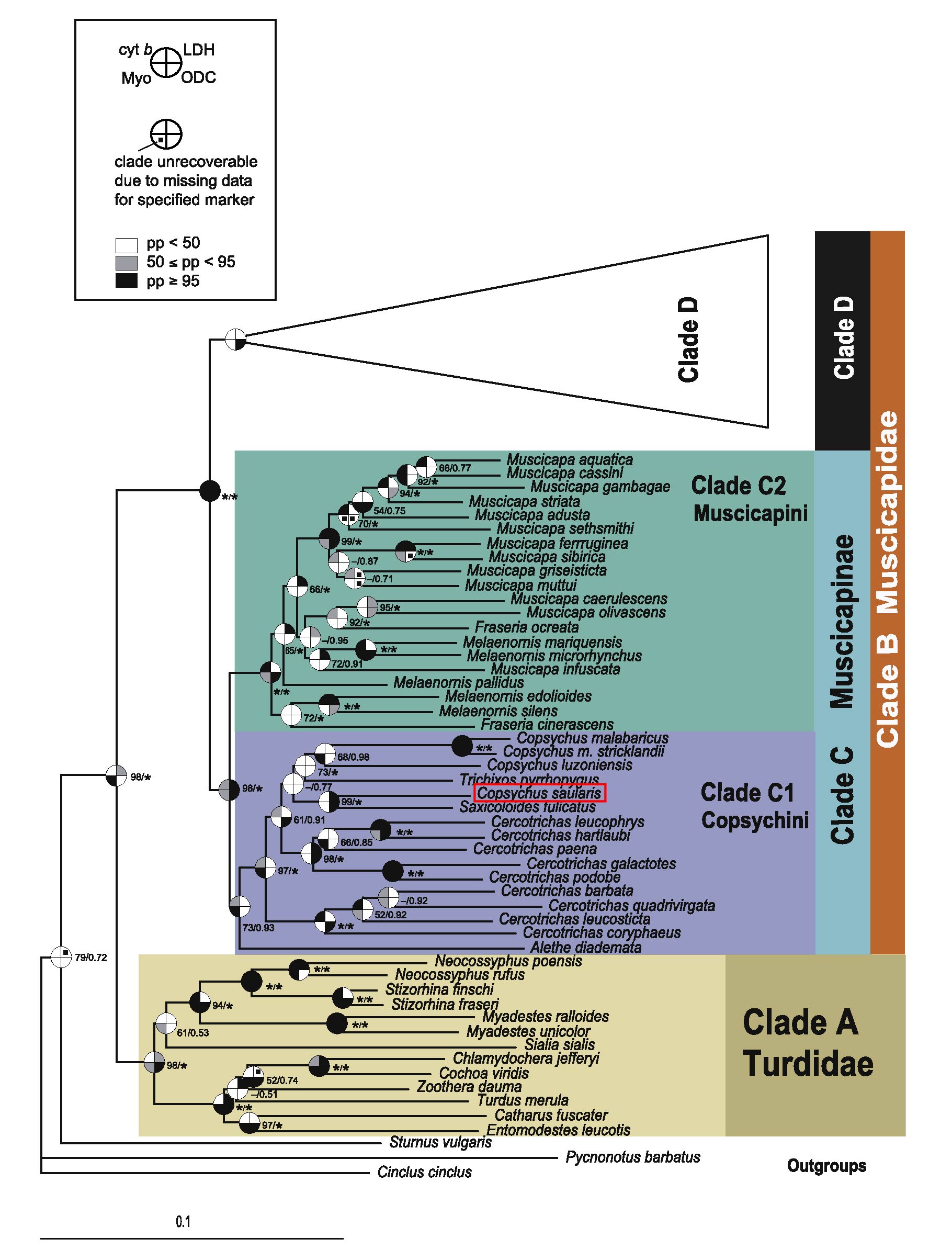Table of Contents
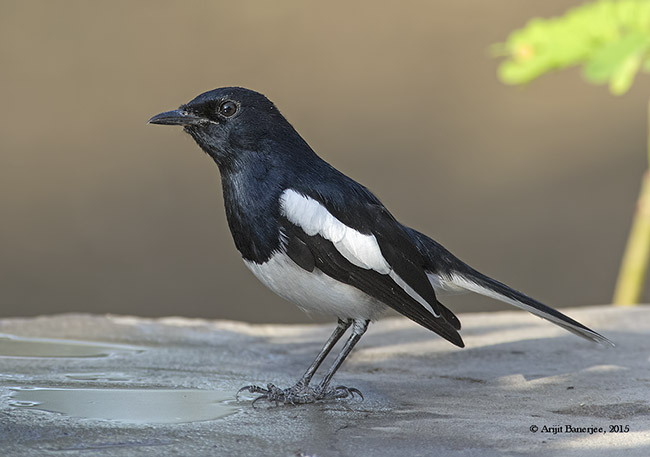 |
| Photograph by Arijit Banerjee (2015) |
Overview
The Oriental Magpie-robin (Copsychus saularis) is an unmistakable small passerine that is resident throughout its extensive range, including Singapore [1] . In Singapore, the species used to be one of the most common birds [2] . However, with habitat lost and competition from introduced bird species, the Oriental Magpie-robin's population drastically declined [3] [4] . Its population was further reduced by poaching, both in Singapore and most of its Southeast Asian range, as the Oriental Magpie-robin is highly soughed after by the caged bird trade for its charismatic song [5] [6] . In recent years, the local population is recovering and can be found throughout Singapore.Etymology
The Oriental Magpie-robin is neither a magpie nor a robin, but is in fact an old world flycatcher (see section on Phylogeny). Its common name originated from its black and white plumage resembling a magpie, while its jerky movements, tail fanning, and confiding habits resembles that of a robin[7] . Its common name was revised from just Magpie-robin to Oriental Magpie-robin to conform to general world usage [8] .The species epithet of the Oriental Magpie-robin, saularis, derives from the Hindi name saulary. Earlier authors suggest that Linnaeus, thinking that Latham's 'Dial-bird' (Hindi dhaiyal, magpie robin) had something to do with a sun-dial, meant to name it solaris (Latin solaris, solar, of the sun) but by a slip of the pen wrote saularis [9] .
Description
Descriptions are based on Wells (2007) [10] and specific to the subspecies found in Singapore.The Oriental Magpie-robin is a medium sized bird of 19 -21 cm that exhibits sexual dimorphism [11] . Features present in all are black bills and slaty black legs[12] .
Diagnosis
The Oriental Magpie-robin is easily mistaken for the White-rumped Shama (Copsychus malabaricus), a closely related species, due to the similar built and head colouration. It has also been confused with the Pied Fantail (Rhipidura javanica) because of the similar pied plumage that both species share. All three species occur in Singapore.| Oriental Magpie-robin (Copsychus saularis)[13] |
White-rumped Shama (Copsychus malabaricus)[14] |
Pied Fantail (Rhipidura javanica)[15] |
||||||
|
|
|
||||||
|
|
|
Habitat and Distribution
Habitat
Oriental Magpie-robins inhabit a spectrum of habitats that include dry deciduous forest, disturbed peatswamp-forest, along the banks of large rivers through forest, forest edges, bamboo, gardens, parkland, and beach strand vegetation[16] . In Singapore, the species occurs in mangroves, secondary forests, forest edges, gardens, and parks [17] .Global Range
The Oriental Magpie-robin has a huge global range extending across 9 countries, from the Indian subcontinent to Borneo and Bali. The species has been recorded to be an established exotic in Taiwan that is increasing in numbers [18] . The species can be found at elevations of up to 1900m [19] . Across its vast distribution, variation in plumage character suggests multiple species may be present in the species, with a recent taxonomic split of the Philippine population (see section on Phylogeny).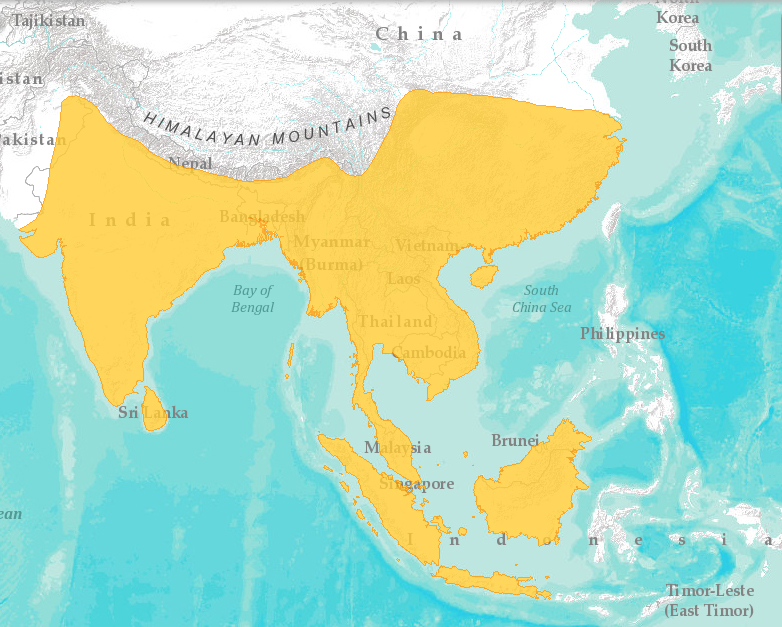 |
| Global range of the Oriental Magpie-robin (Copsychus saularis), indicated in orange (adapted and modified from IUCN, 2015 to reflect recent taxonomic changes) |
Distribution in Singapore
In Singapore, it is an uncommon resident found in nature areas throughout mainland and offshore islands[20] , refer to the map below for specific localities (the map was complied from various sources[21] [22] [23] [24] and personal observations).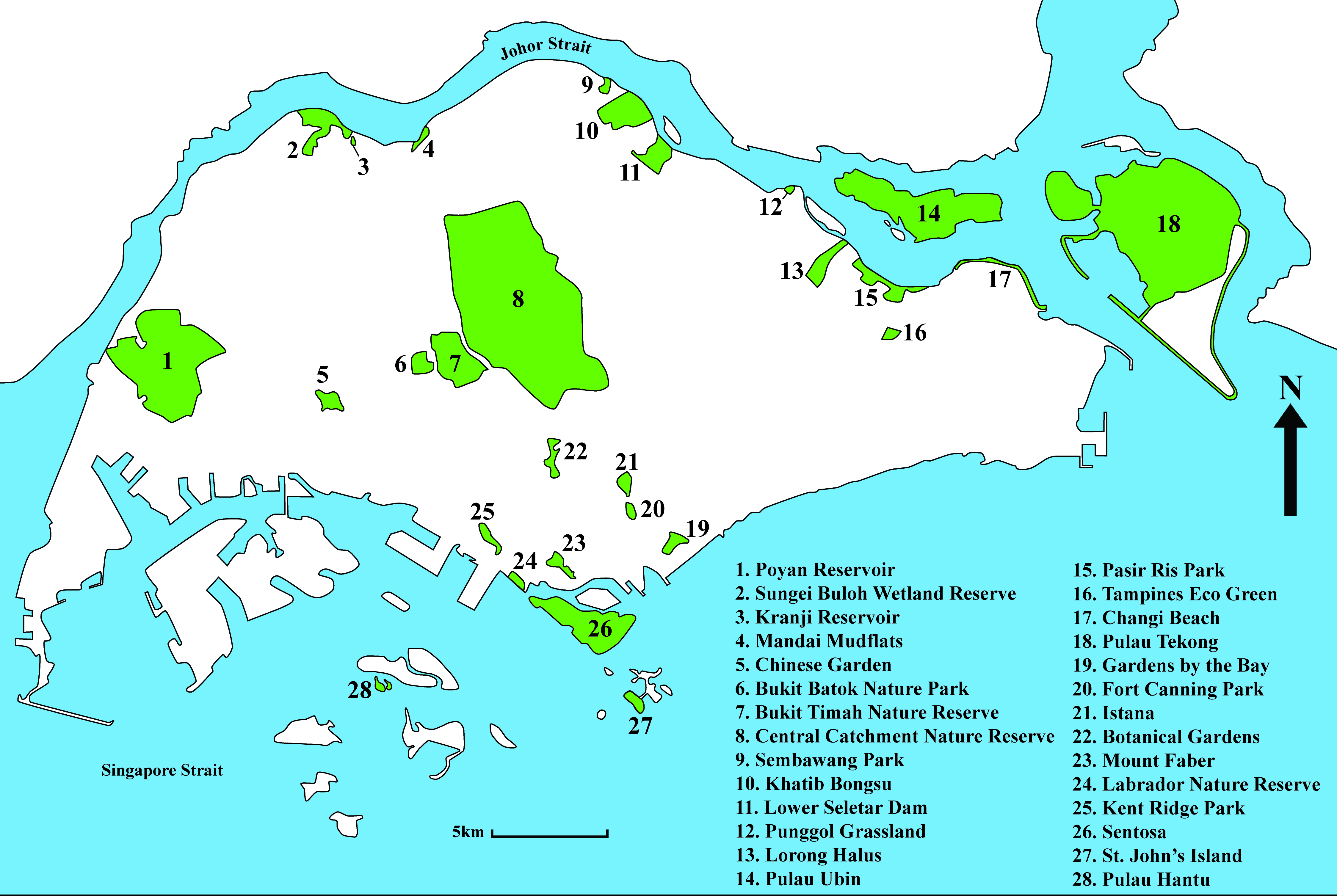 |
| Map of Singapore with green areas indicating areas where the Oriental Magpie-robins have been sighted (Image by Elize Ng, 2015). |
Biology
Vocalization
The prized asset of the Oriental Magpie-robin is none other than its strong melodious song that is highly variable. Its song has been described to be similar to the song of the White-rumped Shama but lack similar quality [25] . The Oriental Magpie-robin has the ability to mimic the songs of other birds. Unfortunately, its song is also appreciated by man which led to its decline in parts of Southeast Asia (see section on Global Threats and Threats in Singapore).Songs of the Oriental Magpie-robin include rather sharp warbled phrases interspersed with held or up- or down-inflected glissalding whistles. The Oriental Magpie-robin is also known to have six call types that include - dawn emergence and roosting calls, threat calls, submissive calls, begging calls and distress calls [26] . The Oriental Magpie-robin is known to perch on open posts to sing [27] .
Video records of the variable songs capable of the Oriental Magpie-robin:
A raspy alert call by a male, with sonogram depicting the call in a series of bars:
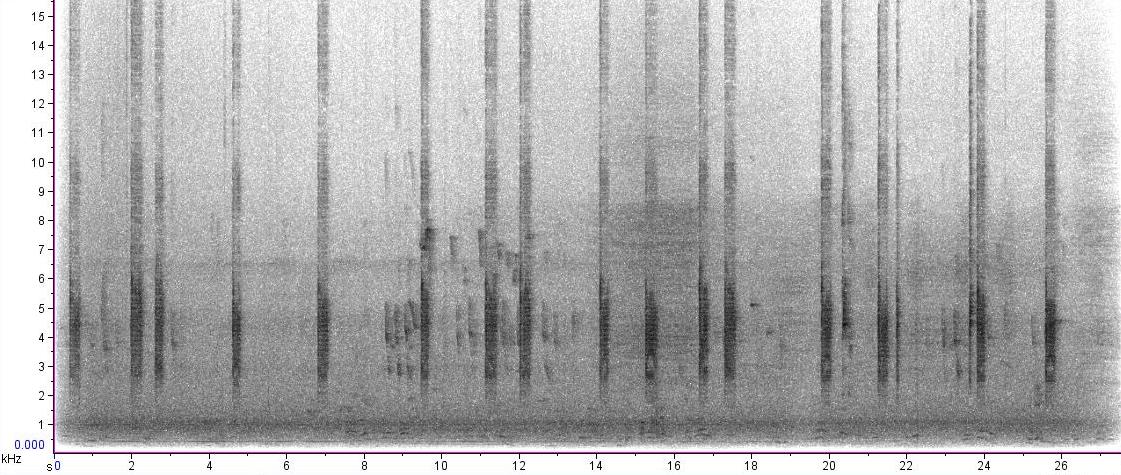
Recording by Josep del Hoyo (2012)
Social Organisation and Interactions
The Oriental Magpie-robin is a resident breeder within its range and is know to be an active disperser [28] [29] . They are extremely territorial and both sexes will aggressively defend their territory, especially during breeding season [30] . During the breeding season, mean territorial ranges are about 1.3ha [31] . Both sexes regularly cock their tails vertically and fan it to expose the white margins [32] .Feeding Habits
The Oriental Magpie-robin is typically insectivorous and feeds on a range of insects — crickets, beetles, ants, wasps, termites, and flies — and other invertebrates that include leeches, molluscs, crabs, and spiders[33] . In certain instances, small vertebrates such as lizards[34] , geckos, and fishes; nectar, seeds, and fruits are also consumed [35] .The Oriental Magpie-robin feeds largely on the ground, hopping about in an upright stance [36] . They are also known to have shrike-like still-hunting from a vantage perch and capture ground animal prey, especially small vertebrates [37] . The species is usually seen foraging solitary or in pairs[38] .
|
|
Video of a male capturing a grasshopper whilst hopping on the ground
Reproduction
Oriental Magpie-robins have nesting sites in natural cavities 2 - 7m above ground in the axil of palm fronds, rotten tree stumps, hollow logs, and broken bamboo clumps, amongst others [39] [40] . Artificial equivalents include letter boxes[41] , and electrical switch boxes [42] . Nests are often filled with pads of grass, fibers, hair, feathers, snakeskin. Nests are constructed between January and June.The eggs are blue green with brown molting[43] . Generally, 2-5 eggs are laid and they are incubated for periods of up to weeks [44] . A second clutch of eggs are sometimes laid even before the full independence of the first brood [45] . Both male and female tend to their young . Juveniles from the first brood were recorded to assist their parents in feeding the second brood of nestlings[46] .
|
|
Anting Behaviour
The Oriental Magpie-robin has been observed to practice anting - the application of ants or any other insects to their plumage [47] . The functional behaviour for anting is still vague, but it has been hypothesized to include: removing ectoparasites, grooming feathers, decreasing skin irritation during moult, and acting as a sensory stimulus [48] .Video of an Oriental Magpie-robin anting with a millipede
Conservation Status
IUCN Status
The Oriental Magpie-robin is listed as least concerned on the IUCN red list in 2012 due to its large range, and stable global population size which according to the range size criterion does not reach Vulnerable thresholds[49] . The global population was not quantified but known to be common in India, Sri Lanka, China, Hong Kong, Thailand [50] . Since the inception of the IUCN red list, this species has always been listed as a species of least concern.Global Threats
Prized for its melodious song, the Oriental Magpie-robin has been poached to near extinction in Indonesia [51] [52] . Its decline is mainly fueled by songbird competitions, a popular hobby in Indonesia, with Oriental Magpie-robins having an official song contest class. It is the third most popular and prestigious species after the Long tailed Shrike (Lanius schach) and White-rumped Shama (Copsychus malabaricus) [53] . Based on market surveys, the species is proposed to be severely declining [54] .Besides being captured for the caged bird trade, Oriental Magpie-robins are also trapped for its meat in Medan as it is believed to cure speaking disorders[55] . In Vietnam, Oriental Magpie-robins are one of many species captured indiscriminately for merit release by Buddhist believers daily [56] .
Video of poachers trapping the Oriental Magpie-robin using a caged individual to lure wild individuals:
Video of poached birds, including an Oriental Magpie-robin (at 4:59) sold in a Vietnam bird market:
Video of Oriental Magpie-robins competing in a song competition:
Threats in Singapore
During the 1920s, the Oriental Magpie-robin was one of three most common birds in Singapore [57] . By the 1940s, its population was declining, and by the 1960s it is recognized as being uncommon. Its decline was attributed to rapid urbanisation which resulted in habitat loss and poaching [58] [59] . Additionally, competition for nesting space from more aggressive and abundant exotic species such as the White-vented Myna (Acridotheres javanicus) and Common Myna (Acridotheres tristis) also contributed to its decline[60] . By 1984, there were only 15 wild individuals found on mainland [61] . A reintroduction program started in 1984 with about 40 releases over a two year period in various protected areas reversed the decline, but progress was slow [62] [63] . In a 1996 survey, only 114 birds were recorded [64] . The species is considered to be endangered in Singapore[65] .Despite being punishable by law, poaching of wildlife (including Oriental Magpie-robins) still occur in Singapore, albeit to a lesser extent[66] . Penalties for poaching wildlife in Singapore are:
- Under the Wild Animals and Birds Act (Chapter 351), it is an offence to kill, take or keep any wild animal or bird without a licence. Any person found doing so will be fined a maximum of S$1,000.
- Under the Parks and Trees Act (Chapter 216), it is an offence to capture, collect or remove any animal from the national parks and nature reserves. Any person found guilty of an offence can be fined up to S$50,000 or jailed for up to 6 months, or both.
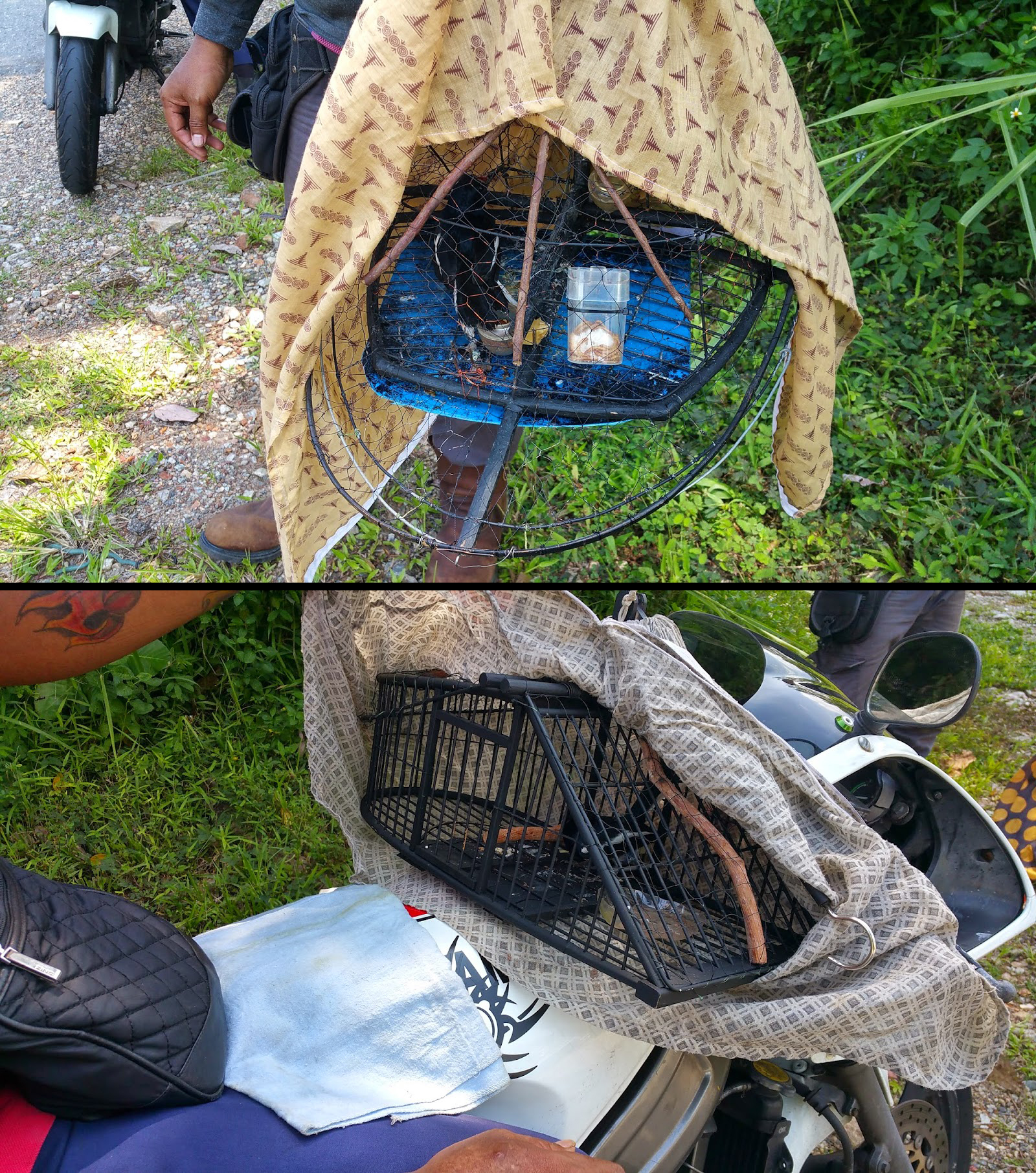 |
| Poachers in Singapore using traps to capture Oriental Magpie-robins at Lim Chu Kang. Photographs by nd1370sg (Permission pending). Click on photograph to visit original blog post. |
What can be done if poaching is observed (adapted from ACRES website):
- Collect information, photographs or video evidence, of the traps, poachers, and any animals trapped. If the poacher uses a vehicle, take note of the license plate number and photograph of it.
- Call the relevant authorities:
- If you are inside a protected area, contact NParks at their hotline 1800 4717300.
- Alternatively, you can contact AVA hotline 1800 2262250 or +65 63257625.
- If you are unable to contact any of the above numbers, you can contact ACRES Wildlife Crime Hotline +65 97837782. Note: They are not an enforcement agency but they will be able to go to the site and wait for the authorities to arrive. - Do not attempt to release any trapped animals, wait for the authorities to arrive.
Taxonomy and Systematics
A hierarchical summary of the taxa within which the Oriental Magpie-robin is provided below:Animalia
- Chordata
- Aves
- Passeriformes
- Muscicapidae
- Copsychus (Wagler, 1827)
- Copsychus saularis (Linnaeus, 1758)
- Copsychus (Wagler, 1827)
- Muscicapidae
- Passeriformes
- Aves
Subspecies
There are 13 subspecies that are currently recognized[67] and C. s. musicus is the subspecies present in Singapore.| Subspecies |
Distribution |
| C. s. saularis (Linnaeus, 1758) |
Northeast Pakistan, and north, central and west India |
| C. s. ceylonensis Sclater, 1861 |
South India and Sri Lanka |
| C. s. erimelas Oberholser, 1923 |
Northeast India to Thailand and Indochina |
| C. s. andamanensis Hume, 1874 |
Andaman Island |
| C. s. prosthopellus Oberholser, 1923 |
South and east China, Hainan Island (off Southeast China) |
| C. s. musicus (Raffles, 1822) |
Peninsular Malaysia, Sumatra, Belitung and Bangka Island, west Java, and south and west Borneo |
| C. s. zacnecus Oberholser, 1912 |
Simeulue Island (off Northwest Sumatra) |
| C. s. nesiarchus Oberholser, 1923 |
Nias Island (off Northwest Sumatra) |
| C. s. masculus Ripley, 1943 |
Batu Island (off West Sumatra) |
| C. s. pagiensis Richmond, 1912 |
Mentawai Island (off West Sumatra) |
| C. s. amoenus (Horsfield, 1821) |
East Java and Bali |
| C. s. pluto Bonaparte, 1850 |
Maratua Island, and east and southeast Borneo |
| C. s. adamsi Elliot, 1890 |
North Borneo and Banggi Island |
Type Specimen
The species was first described by Linneaus (1758) from Bengal[68] with the protonym, Gracula saularis. The type specimen is believed to be currently held at the Natural History Museum of Vienna that acquired specimens from the world famous Leverian Museum[69] [70] . |
| Original description by Linnaeus (1758) |
Phylogeny
The Oriental Magpie-robin was historically associated with the thrushes (Turdidae)[71] [72] based on the speckling on plumage in juveniles and the presence of a thumb-like syrinx musculature[73] . Recent molecular studies found that the Oriental Magpie-robin was more closely related to the old world flycatchers and chats (Muscicapidae) and was reclassified accordingly [74] [75] [76] .
|
|
A study on the Shamas and Magpie-robins revealed that the Rufous-tailed Shama (Trichixos pyrropygus) is sister to the Magpie-robins, and together they are sister to the Copsychus Shamas[77] . The study also revealed that C. albospecularis of Madagascar and C. sechellarum of Seychelles are sister to the Oriental Magpie-robin (C. saularis).
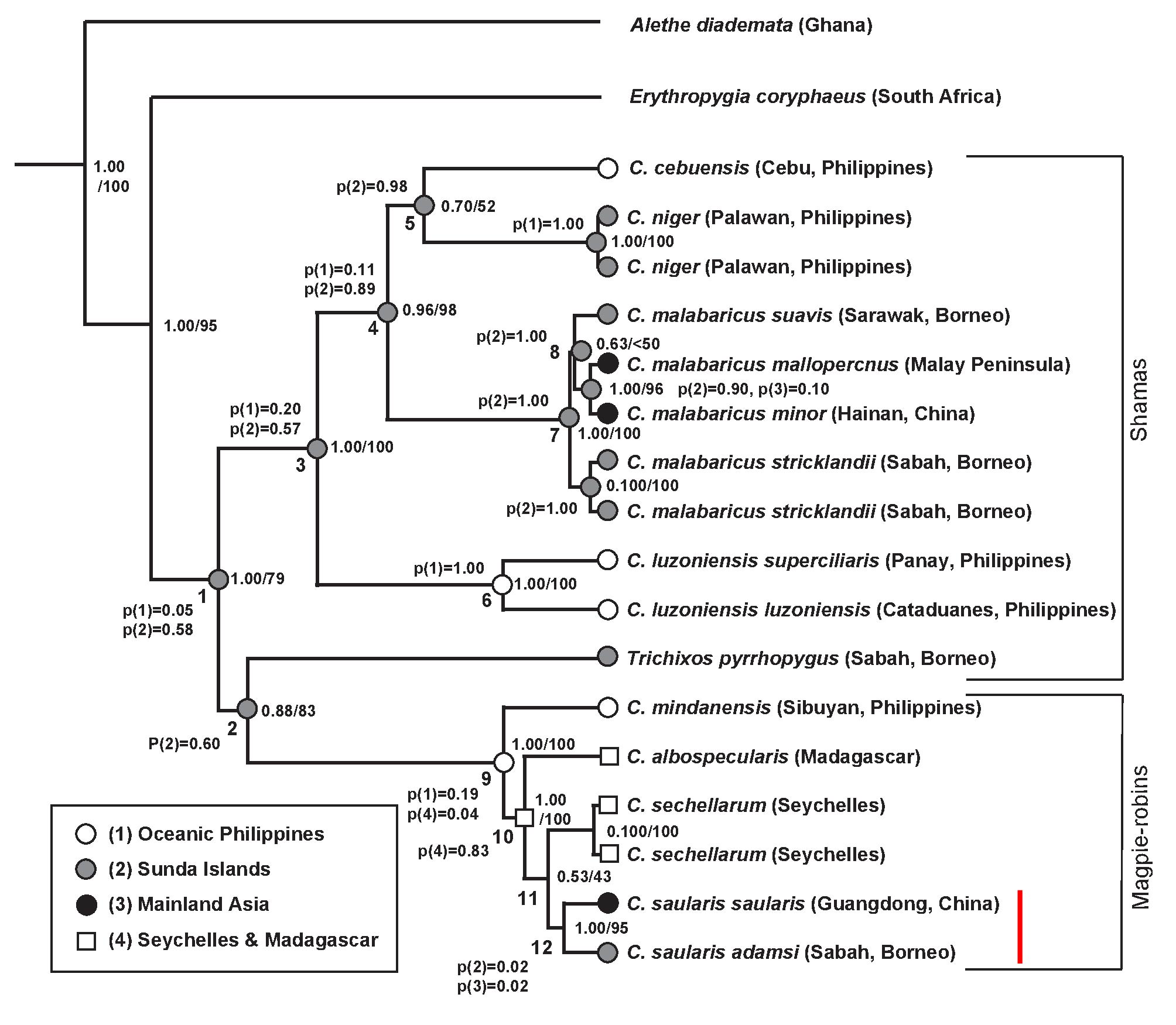 |
| Phylogeny of Copsychus and Trichixos estimated by Bayesian analysis and maximum likelihood (ML) bootstrapping. Branch support numbers are Bayesian/ML-bootstrapping values, respectively. The Oriental Magpie-robin's position is indicated by the red line. (Figure adapted from Lim et al., 2010) |
Within the Magpie-robins, C. saularis was found to be polyphyletic as the Malagasy population (C. albospecularis) was between the Philippine and the remaining C. saularis populations [78] . The study went on to propose for the Philippine population to be recognized as a distinct species on the basis that it is not monophyletic with other C. saularis populations, distinctive plumage (all black tail), and substantial genetic difference (6%). The Philippine population has since been recognized as a species in recent checklists [79] [80] [81] .
The phylogenetic relationship of Oriental Magpie-robins from Singapore are inconclusive as the sample(s) may have originated from elsewhere (Sumatra or Java), which resulted in the substantial divergence between the Singapore individuals (31 and 32 in figure below) [82] . There was minimal genetic differences (1%) between the Sino-Indian and western Sundaic Magpie-robins, which were then included within C. saularis [83] .
Black-bellied taxa from east Borneo (adamsi and pluto; individuals from clade C in figure below) and presumably east Java (amoenus) have substantial genetic differences from the remaining populations constituting C. saularis [84] . Despite distinct plumage and genetic differences, the black-bellied taxa hybridized with the white-bellied individuals of C. s. musicus. These hybrid individuals have intermediate plumage and occurred widely on both side of the contact zone. As such the Sheldon et al. (2009) conservatively subsumed the black-bellied taxa in C. saularis.
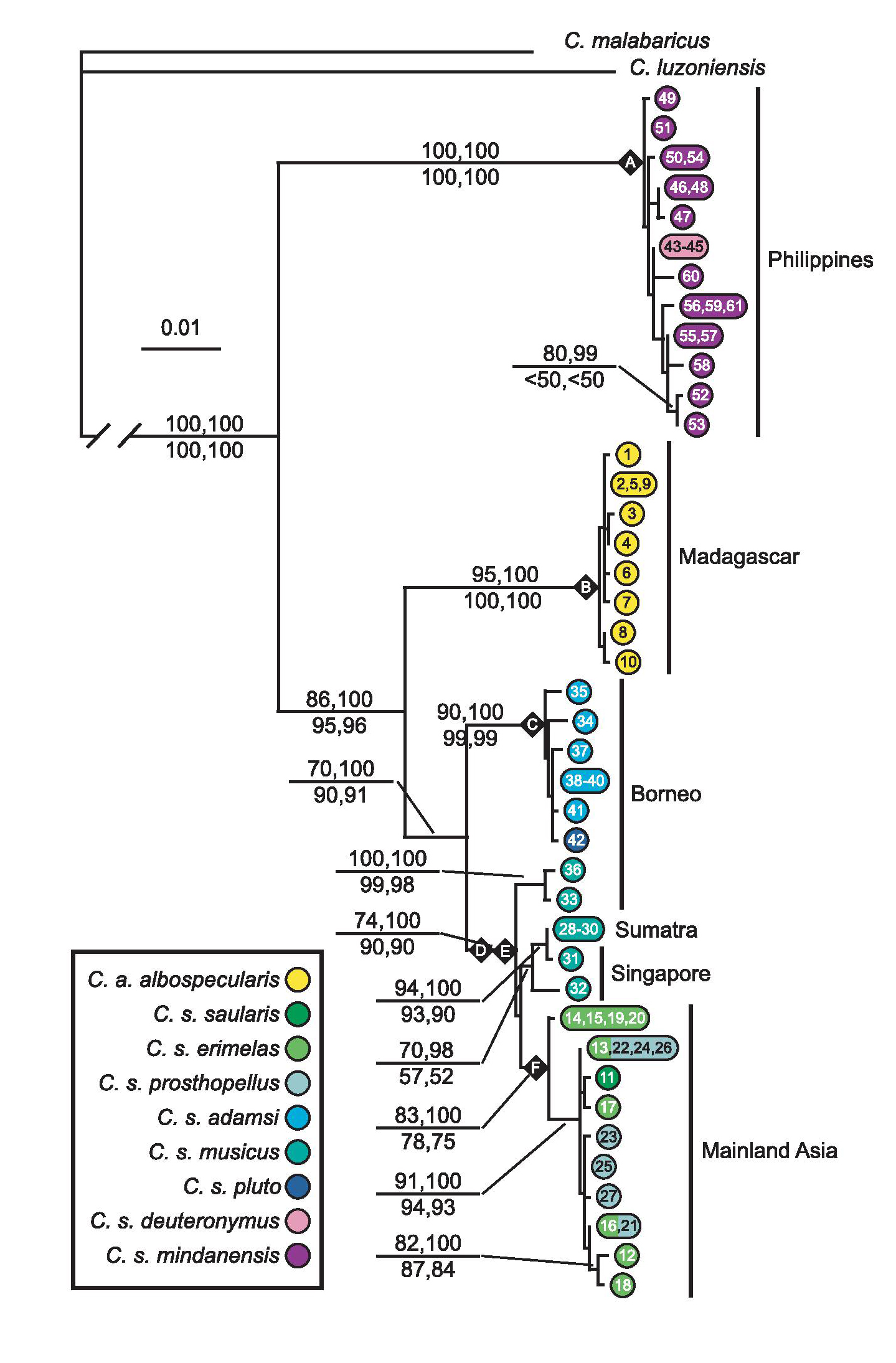 |
| Maximum likelihood phylogenetic estimate of Magpie-robin (Copsychus saularis and Copsychus albospecularis) mitochondrial haplotypes based on mtDNA sequence (ND2 and COI). Numbers above branches indicate maximum likelihood bootstrap support and Bayesian posterior probabilities, respectively, and support measures below branches indicate symmetric resampling and jackknife parsimony support, respectively. (Figure adapted from Sheldon et al., 2009) |
Genetic Resources
Genbank has barcode sequences of the Oriental Magpie-robin for several genes including: ND2, CO1, Fib5 and ctyb. The full genome of the Oriental Magpie-robin has not been sequenced, and the closest reference genome for the species will be the Collared Flycatcher (Ficedula albicollis).Literature Cited
- ^ Collar, N., 2005. Family Turdidae (Thrushes). In: del Hoyo, J., A., Elliott, J. Sargatal, D. A.Christie & E. de Juana (eds), Handbook of the Birds of the World Alive. Lynx Edicions, Barcelona. Pp. 514-807.
- ^ Bucknill J. A. & F. N. Chasen, 1927. Birds of Singapore and South-east Asia. Tynron, Scotland. 234 pp.
- ^ Huong, S. L. & N. S. Sodhi, 1997. The status of the oriental magpie robin, Copsychus saularis, in Singapore. Malayan Nature Journal, 50: 346-354.
- ^ Davison, G. W. H., P. K. L. Ng & H. C. Ho, 2008. The Singapore Red Data Book: Threatened Plants and Animals of Singapore. 2nd edition. Nature Society (Singapore), Singapore. 285 pp.
- ^ Chng, S. C. L., J. A. Eaton, K. Krishnasamy, C. R. Shepherd & V. Nijman, 2015. In the market for extinction: An inventory of Jakarta's bird markets. TRAFFIC. Malaysia, Selangor. 40 pp.
- ^ Gibson-Hill, C. A., 1949. An annotated checklist of the birds of Malaya. Bulletin of the Raffles Museum, 20: 1-299.
- ^ Bucknill, J. A. S. & F. N. Chasen, 1990. Birds of Singapore and South-east Asia. Graham Brash, Singapore. 247 pp.
- ^ Chesser, R. T., R. C. Banks, F. K. Barker, C. Cicero, J. L. Dunn, A. W. Kratter, J. J. Lovette, P. C. Rasmussen, J. V. Remsen, J. D. Rising, D. F. Stotz & K. Winker, 2012. Fifty-third supplement to the American Ornithologists' Union check-list of North American Birds. The Auk, 130(3): 573-588.
- ^ Pittie, A., 2004. A dictionary of scientific bird names originating from the Indian region. Buceros, 9(2): 1-30.
- ^ Wells, D., 2007. Birds of the Thai-Malay Peninsula: Passerines: Volume 2. Christopher Helm Publishers Ltd, London. 848 pp.
- ^ Robson, C., 2015. Birds of South-East Asia. Second Edition. Christopher Helm Publishers Ltd, London. 544 pp.
- ^ Wells, D., 2007. Birds of the Thai-Malay Peninsula: Passerines: Volume 2. Christopher Helm Publishers Ltd, London. 848 pp.
- ^ Collar, N., 2005. Family Turdidae (Thrushes). In: del Hoyo, J., A., Elliott, J. Sargatal, D. A.Christie & E. de Juana (eds), Handbook of the Birds of the World Alive. Lynx Edicions, Barcelona. Pp. 514-807.
- ^ Collar, N., 2005. Family Turdidae (Thrushes). In: del Hoyo, J., A., Elliott, J. Sargatal, D. A.Christie & E. de Juana (eds), Handbook of the Birds of the World Alive. Lynx Edicions, Barcelona. Pp. 514-807.
- ^ Boles, W., 2006. Family Fantail (Rhipiduridae). In: del Hoyo, J., A., Elliott, J. Sargatal, D. A.Christie & E. de Juana (eds), Handbook of the Birds of the World Alive. Lynx Edicions, Barcelona. Pp. 200 - 242.
- ^ Collar, N., 2005. Family Turdidae (Thrushes). In: del Hoyo, J., A., Elliott, J. Sargatal, D. A.Christie & E. de Juana (eds), Handbook of the Birds of the World Alive. Lynx Edicions, Barcelona. Pp. 514-807.
- ^ Lim, K. S., 2009. The Avifauna of Singapore. Nature Society (Singapore), Singapore. 611 pp.
- ^ Brazil, M., 2009. Birds of East Asia: China, Taiwan, Korea, Japan, and Russia. Christopher Helm, London. 528 pp.
- ^ Collar, N., 2005. Family Turdidae (Thrushes). In: del Hoyo, J., A., Elliott, J. Sargatal, D. A.Christie & E. de Juana (eds), Handbook of the Birds of the World Alive. Lynx Edicions, Barcelona. Pp. 514-807.
- ^ Lim, K. S., 2009. The Avifauna of Singapore. Nature Society (Singapore), Singapore. 611 pp.
- ^ Lim, K. C. & K. S. Lim, 2009. State of SIngapore's Wild Birds and Bird Habitats: A review of the Annual Bird Census 1996 - 2005. Nature Society (Singapore), Singapore. 402 pp.
- ^ Lim, K. S., 2009. The Avifauna of Singapore. Nature Society (Singapore), Singapore. 611 pp.
- ^ National Parks Board, 2013. Copsychus saularis (Linnaeus, 1758). Flora Fauna Web - animal details. URL: https://florafaunaweb.nparks.gov.sg/Special-Pages/animal-detail.aspx?id=748 (accessed on 8 Nov 2015).
- ^ Gan, J. W. M. & A. Lau, 2005. Birds seen at the Istana. Singapore Environment Council, Singapore. 104 pp.
- ^ MacKinnon, J., 1988. Field guide to the birds of Java and Bali. Gadjah Mada University Press, Yogyakarta. 390 pp.
- ^ Collar, N., 2005. Family Turdidae (Thrushes). In: del Hoyo, J., A., Elliott, J. Sargatal, D. A.Christie & E. de Juana (eds), Handbook of the Birds of the World Alive. Lynx Edicions, Barcelona. Pp. 514-807.
- ^ Ng, P. K. L., R. T. Corlett & H. T. W. Tan, 2011. Singapore Biodiversity: An Encyclopedia Of The Natural Environment And Sustainable Development. Didier Millet, Singapore. 552 pp.
- ^ Wells, D., 2007. Birds of the Thai-Malay Peninsula: Passerines: Volume 2. Christopher Helm Publishers Ltd, London. 848 pp.
- ^ Collar, N., 2005. Family Turdidae (Thrushes). In: del Hoyo, J., A., Elliott, J. Sargatal, D. A.Christie & E. de Juana (eds), Handbook of the Birds of the World Alive. Lynx Edicions, Barcelona. Pp. 514-807.
- ^ Wells, D., 2007. Birds of the Thai-Malay Peninsula: Passerines: Volume 2. Christopher Helm Publishers Ltd, London. 848 pp.
- ^ Sreekar, R., 2010. A study on the habits of Oriental Magpie-Robin Copsychus saularis. Indian Birds, 5(5): 152–153.
- ^ Wells, D., 2007. Birds of the Thai-Malay Peninsula: Passerines: Volume 2. Christopher Helm Publishers Ltd, London. 848 pp.
- ^ Collar, N., 2005. Family Turdidae (Thrushes). In: del Hoyo, J., A., Elliott, J. Sargatal, D. A.Christie & E. de Juana (eds), Handbook of the Birds of the World Alive. Lynx Edicions, Barcelona. Pp. 514-807.
- ^ Kwong, W. C., 2010. Oriental Magpie-robin catching lizards. Bird Ecology Study Group, 20 Jul 2010. URL: http://www.besgroup.org/2010/07/20/oriental-magpie-robin-catching-lizards/ (accessed on 17 Oct 2015).
- ^ Collar, N., 2005. Family Turdidae (Thrushes). In: del Hoyo, J., A., Elliott, J. Sargatal, D. A.Christie & E. de Juana (eds), Handbook of the Birds of the World Alive. Lynx Edicions, Barcelona. Pp. 514-807.
- ^ Collar, N., 2005. Family Turdidae (Thrushes). In: del Hoyo, J., A., Elliott, J. Sargatal, D. A.Christie & E. de Juana (eds), Handbook of the Birds of the World Alive. Lynx Edicions, Barcelona. Pp. 514-807.
- ^ Wells, D., 2007. Birds of the Thai-Malay Peninsula: Passerines: Volume 2. Christopher Helm Publishers Ltd, London. 848 pp.
- ^ Jeyarajasingam, A., 2012. A field guide to the birds of Peninsular Malaysia and Singapore (2nd Edition). Oxford University Press, Oxford. 484 pp.
- ^ ollar, N., 2005. Family Turdidae (Thrushes). In: del Hoyo, J., A., Elliott, J. Sargatal, D. A.Christie & E. de Juana (eds), Handbook of the Birds of the World Alive. Lynx Edicions, Barcelona. Pp. 514-807.
- ^ Wells, D., 2007. Birds of the Thai-Malay Peninsula: Passerines: Volume 2. Christopher Helm Publishers Ltd, London. 848 pp.
- ^ Amar-Singh H. S. S., 2010. Oriental Magpie-robins nesting in a mail box. Bird Ecology Study Group, 5 Jul 2011. URL: http://www.besgroup.org/2011/07/05/oriental-magpie-robin-nesting-in-a-mailbox/ (accessed on 17 Oct 2015).
- ^ Wells, D., 2007. Birds of the Thai-Malay Peninsula: Passerines: Volume 2. Christopher Helm Publishers Ltd, London. 848 pp.
- ^ Wells, D., 2007. Birds of the Thai-Malay Peninsula: Passerines: Volume 2. Christopher Helm Publishers Ltd, London. 848 pp.
- ^ Collar, N., 2005. Family Turdidae (Thrushes). In: del Hoyo, J., A., Elliott, J. Sargatal, D. A.Christie & E. de Juana (eds), Handbook of the Birds of the World Alive. Lynx Edicions, Barcelona. Pp. 514-807.
- ^ Wells, D., 2007. Birds of the Thai-Malay Peninsula: Passerines: Volume 2. Christopher Helm Publishers Ltd, London. 848 pp.
- ^ Wells, D., 2007. Birds of the Thai-Malay Peninsula: Passerines: Volume 2. Christopher Helm Publishers Ltd, London. 848 pp.
- ^ Kwong, W. C., 2013. Oriental Magpie-robin anting. Bird Ecology Study Group, 28 Sep 2013. URL: http://www.besgroup.org/2013/09/28/oriental-magpie-robin-anting/ (accessed on 23 Nov 2015)
- ^ Morozov, N. S., 2015. Why do birds practice anting? Biology Bulletin Reviews, 5(4): 353-365.
- ^ BirdLife International. 2012. Copsychus saularis. The IUCN Red List of Threatened Species 2012. URL: http://dx.doi.org/10.2305/IUCN.UK.2012-1.RLTS.T22709988A39750673.en . (accessed 19 Oct 2015).
- ^ Collar, N., 2005. Family Turdidae (Thrushes). In: del Hoyo, J., A., Elliott, J. Sargatal, D. A.Christie & E. de Juana (eds), Handbook of the Birds of the World Alive. Lynx Edicions, Barcelona. Pp. 514-807.
- ^ Chng, S. C. L., J. A. Eaton, K. Krishnasamy, C. R. Shepherd & V. Nijman, 2015. In the market for extinction: An inventory of Jakarta's bird markets. TRAFFIC. Malaysia, Selangor. 40 pp.
- ^ Shepherd, C. R., J. Sukumaran & S. A. Wich, 2004. Open Season: An analysis of the pet trade in Medan, Sumatra 1997 - 2001. TRAFFIC Southeast Asia, Selangor. 67 pp.
- ^ Jepson, P., 2008. Orange-headed Thrush Zoothera citrina and the avian X-factor. BirdingASIA, 9: 58-60.
- ^ Harris, J. B. C., J. M. H. Green, D. M. Prawiradilaga, X Giam, G. D. Hikmatullah, C. A. Putra & D. S. Wilcove, 2015. Using market data and expert opinion to identify overexploited species in the wild bird trade. Biological Conservation, 187: 51-60.
- ^ Shepherd, C. R., J. Sukumaran & S. A. Wich, 2004. Open Season: An analysis of the pet trade in Medan, Sumatra 1997 - 2001. TRAFFIC Southeast Asia, Selangor. 67 pp.
- ^ Gilbert, M., C. Sokha, P. H. Joyner, R. L. Thomson & C. Poole, 2012. Characterizing the trade of wild birds for merit release in Phnom Penh, Cambodia and associated risks to health and ecology. Biological Conservation, 153(2012): 10-16.
- ^ Bucknill, J. A. S. & F. N. Chasen, 1990. Birds of Singapore and South-east Asia. Graham Brash, Singapore. 247 pp.
- ^ Goh, B. P. L., N. Sodhi, D. Li, S. H. Ho & P. K. L. Ng, 2002. A guide to urban creatures. Singapore Science Centre, Singapore. 160 pp.
- ^ Gibson-Hill, C. A., 1949. An annotated checklist of the birds of Malaya. Bulletin of the Raffles Museum, 20: 1-299.
- ^ Huong, S. L. & N. S. Sodhi, 1997. The status of the Oriental Magpie Robin, Copsychus saularis, in Singapore. Malayan Nature Journal, 50: 346-354.
- ^ Hails, C. J. & O. Mueller, 1984. Surveying and ringing in Singapore. Interwader Annual Report 2: 119-126.
- ^ Lim, K. S., 1992. Vanishing birds of Singapore. The Nature Society (Singapore), Singapore. 103 pp.
- ^ Lim, K. S., 1989. Endangered birds and their conservation: the Singapore context. Singapore Avifauna, 3(7): 14-30.
- ^ Goh, B. P. L., N. Sodhi, D. Li, S. H. Ho & P. K. L. Ng, 2002. A guide to urban creatures. Singapore Science Centre, Singapore. 160 pp.
- ^ Davison, G. W. H., P. K. L. Ng & H. C. Ho, 2008. The Singapore Red Data Book: Threatened Plants and Animals of Singapore. 2nd edition. Nature Society (Singapore), Singapore. 285 pp.
- ^ Vinayagan, D., 2011. Review of wild animals and birds act (WABA): Proposals for its improvement. Proceedings of Nature Society, Singapore's Conference on 'Nature Conservation for Sustainable Singapore'. 16th October 2011. Nature Society (Singapore), Singapore. Pp. 65-69.
- ^ Gill, F. & D. Donsker (eds), 2015. IOC World Bird List (v 5.4). URL: http://www.worldbirdnames.org/ (accessed 24 Nov 2015).
- ^ Linnaeus, C., 1758. Systema naturae per regna tria naturae :secundum classes, ordines, genera, species, cum characteribus, differentiis, synonymis, locis. 10th Edition.Laurentius Salvius, Stockholm. Pp. 109.
- ^ Pelzeln, A. V., 2008. On the Birds in the Collection at Vienna obtained from the Leverian Museum. Ibis, 15(2):14-54.
- ^ Donovan, E., 1806. Catalogue of the Leverian Museum : part I[-VI] ... the sale of the entire collection by Messrs. King and Lochee will commence on Monday, the 5th of May, 1806 at twelve o'clock. Leverian Museum, London. 362 pp.
- ^ Mayr, E. & D. Amadon, 1951. A classification of recent birds. American Museum Novitates, 1496: 1–42.
- ^ Wetmore, A., 1960. A classification for the birds of the world. Smithsonian Miscellaneous Collections, 139: 1–37.
- ^ Ames, P. L., 1975. The application of syringeal morphology to the classification of the Old World Insect Eaters (Muscicapidae). Bonner Zoologsche Beitra¨ge, 26: 107–134.
- ^ Voelker, G. & G. M. Spellman, 2004. Nuclear and mitochondrial DNA evidence of polyphyly in the avian superfamily Muscicapoidea. Molecular Phylogenetics and Evolution, 30(2): 386–394.
- ^ Zuccon, D. & P. G. P. Ericson, 2009. A multi-gene phylogeny disentangles the chat-flycatcher complex (Aves: Muscicapidae). Zoologica Scripta, 39(3): 213-224.
- ^ Sangster, G., P. Alström, E. Forsmark & U. Olsson, 2010. Multi-locus phylogenetic analysis of Old World chats and flycatchers reveals extensive paraphyly at family, subfamily and genus level (Aves: Muscicapidae). Molecular Phylogenetics and Evolution, 57(1): 380-392.
- ^ Lim, H. C., F. Zou, S. S. Taylor, B. D. Marks, R. G. Moyle, G. Voelker & F. H. Sheldon, 2010. Phylogeny of magpie‐robins and shamas (Aves Turdidae Copsychus and Trichixos) implications for island biogeography in Southeast Asia. Journal of Biogeography, 37(10): 1894-1906.
- ^ Sheldon, F. H., D. J. Lohman, H. C. Lim, F. Zou, S. M. Goodman, D. M. Prawiradilaga, K. Winker, T. M. Braile & R. G. Moyle, 2009. Phylogeography of the magpie-robin species complex (Aves: Turdidae: Copsychus) reveals a Philippine species, an interesting isolating barrier and unusual dispersal patterns in the Indian Ocean and Southeast Asia. Journal of Biogeography, 36(6): 1070–1083.
- ^ Dickinson, E. C. & L. Christidis, 2014. The Howard & Moore complete checklist of the birds of the world. Volume 2. Aves Press, Eastbourne. 804 pp.
- ^ Clements, J. F., T. S. Schulenberg, M. J. Iliff, D. Roberson, T. A. Fredericks, B. L. Sullivan & C. L. Wood, 2015. The eBird/Clements checklist of birds of the world: v2015. URL: http://www.birds.cornell.edu/clementschecklist/download/ (accessed 23 Nov 2015).
- ^ Gill, F. & D. Donsker (eds), 2015. IOC World Bird List (v 5.4). URL: http://www.worldbirdnames.org/ (accessed 24 Nov 2015).
- ^ Sheldon, F. H., D. J. Lohman, H. C. Lim, F. Zou, S. M. Goodman, D. M. Prawiradilaga, K. Winker, T. M. Braile & R. G. Moyle, 2009. Phylogeography of the magpie-robin species complex (Aves: Turdidae: Copsychus) reveals a Philippine species, an interesting isolating barrier and unusual dispersal patterns in the Indian Ocean and Southeast Asia. Journal of Biogeography, 36(6): 1070–1083.
- ^ Sheldon, F. H., D. J. Lohman, H. C. Lim, F. Zou, S. M. Goodman, D. M. Prawiradilaga, K. Winker, T. M. Braile & R. G. Moyle, 2009. Phylogeography of the magpie-robin species complex (Aves: Turdidae: Copsychus) reveals a Philippine species, an interesting isolating barrier and unusual dispersal patterns in the Indian Ocean and Southeast Asia. Journal of Biogeography, 36(6): 1070–1083.
- ^ Sheldon, F. H., D. J. Lohman, H. C. Lim, F. Zou, S. M. Goodman, D. M. Prawiradilaga, K. Winker, T. M. Braile & R. G. Moyle, 2009. Phylogeography of the magpie-robin species complex (Aves: Turdidae: Copsychus) reveals a Philippine species, an interesting isolating barrier and unusual dispersal patterns in the Indian Ocean and Southeast Asia. Journal of Biogeography, 36(6): 1070–1083.

